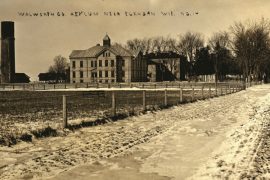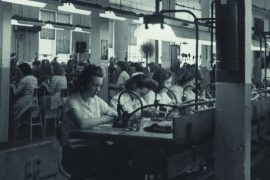By Lisa Schmelz
Cemeteries don’t just bury human remains — they bury history. Last fall, At The Lake unearthed some of that history with a story on Lake Geneva’s Oak Hill Cemetery. This issue, we go back even farther in time. Established in 1837, Pioneer Cemetery, as its name implies, is where many of Lake Geneva’s founding men, women and children were laid to rest.
Until this past summer, if you wanted to stroll through Lake Geneva’s first formal burial ground for white settlers, you had to wait for a holiday when it was open, or call the local powers that be and make a request they may or may not have been able to accommodate. Otherwise, your front row seat to the buried history of Lake Geneva was obscured by a locked iron gate.
Not anymore. In June, Patrick Quinn, a retired Northwestern University archivist, became Pioneer Cemetery’s Keeper of the Keys. It makes sense that Quinn, who amassed collections at Northwestern worthy of placement at the Smithsonian, volunteered for the gig. He lives just across the street from Pioneer, in the same bungalow he grew up in.
Framed by four city streets — Dodge, Maxwell, Warren and Park Row — Pioneer Cemetery, owned by the City of Lake Geneva, is a simple square. It was also a natural extension of Quinn’s boyhood front yard. He played here often, sheltered by a still inviting canopy of oaks, maples and pines.
A number of years ago, nobody knows exactly when, city officials decided Pioneer’s crumbling gravestones might crumble less if the cemetery were locked. Thus began the knocks from a parade of strangers, on their own historic quests, to Quinn’s doorstep.
“They’d stop at the house and say ‘How do we get in there?’ It’s not a big deal for me to do it,” he says. “It should be open.”
The seven men who donated the land for the cemetery, which opened in 1837, would likely agree with Quinn. Those founding fathers were R. Wells Warren, Greeleaf S. Warren, Dr. Phillip Maxwell, Col. James Maxwell, Lewis B. Goodsell, Andrew Ferguson and George Campbell. Known as The Lake Geneva Seven, only two of them — Goodsell and Dr. Phillip Maxwell — are buried here. Alongside those founding fathers, according to Quinn, are also a number of military veterans. World War I veterans George Rich and Warren Rich are buried here. So are 26 Union Army Civil War soldiers, including Lt. Asa Farr, who was killed by Confederate forces in Baxter Springs, Kansas. Veterans of the War of 1812, Zaccheus Gillette and John Powers, are also buried here. Gillette served as a drummer boy, and Powers is believed to as well. But many plots are hard to identify today. Erosion is a natural process for any rock, and softer materials like limestone and sandstone take an even bigger beating. As they were readily available in the 1800s, they were used frequently to mark burial plots. “I would say there’s probably less than 40 percent of the gravestones left here in Pioneer Cemetery,” says Quinn. “The ones that have survived are granite and, to a lesser extent, marble.”
Growing up, Quinn remembers a shed on the north side of the cemetery. As gravestones or pieces of them fell, they were taken here. “The tombstones piled up seven-feet tall,” he says.
What became of them?
“I think they took them to the dump,” he says, his voice lowering.
But not every piece of the past is gone. Dr. Phillip Maxwell is easy to find. His large obelisk serves as a focal point here. Maps outlining who’s buried at Pioneer Cemetery can prove helpful to genealogy enthusiasts, but, cautions Quinn, should not be viewed as completely accurate. One map was compiled by local Girl Scouts in 1976. A detailed directory, using what paper trail was left behind and the Girl Scouts’ research, was done in 2003 by the Walworth County Genealogical Society.
Many who were buried here did not find a final resting place. When Oak Hill opened in the 1880s, a number of families opted to move their loved ones there. The last burial at Pioneer happened in 1977 and this cemetery is not open to burials today. Fortunately, it is open to anyone seeking information about the past or a place to quietly reflect the present.
LAKE GENEVA’S FOUNDERS
PHILLIP MAXWELL
Considered the Father of Lake Geneva, it was Dr. Maxwell who was said to have put up the funds to formally plat the city. Born April 3, 1799 in Vermont, he served in the Legislature of New York and as a surgeon in the U.S. Army. By the time he was discharged in 1839, he’d achieved the rank of Major.
His wife, Jerusha Moore Maxwell, was the sister of J.H. Moore, whose enterprises in the precursors to companies like Nabisco allowed him to build the Loramoor estate, one of the grandest on the shores of Geneva Lake.
The Maxwells’ introduction to Lake Geneva came by way of a winter visit to J.H. Moore’s home here. After that winter, Dr. Maxwell and his family found their way to Chicago, where he practiced medicine and politics. In 1853, he became Illinois State Treasurer. In 1856, the husband and wife set their sights on a retirement in Lake Geneva.
Dr. Maxwell died on November 5, 1859, and was buried in the cemetery he donated land for. His half-brother, Col. James Maxwell, later went to Colorado and is not buried here.
Jerusha Maxwell died on March 27, 1875. Most of the town’s citizens were said to have attended her funeral at the Episcopal Church. She left a then-considerable fortune of $250,000 to her grandchildren. The Maxwell Mansion still stands today, and offers lodging, teas and cabaret entertainment.
Its tall windows, broad entrances, elaborate woodwork, marble fi replaces, and dramatic staircase speaks volumes to Maxwell’s position in the community. Over the years, numerous notables have found rest here, including, General and future U.S. President Ulysses S. Grant, and future First Lady of the United States, Nancy Davis, before she married President Ronald Reagan.
LEWIS B. GOODSELL
Goodsell was a successful Chicago retailer who invested in Lake Geneva. According to the Annals of Lake Geneva, he opened a store in Lake Geneva on the south side of what is now Center Street.
Afflicted with consumption — a kinder, gentler word for tuberculosis — he died in Chicago, trying to make his way back to Lake Geneva after a business trip to New York. The dusty archives of history do not reveal an obituary, or mention whether he was married. The end of his life is simply recorded as having occurred when he “overexerted his strength” and “sank and died upon the wharf.” Goodsell’s gravestone, says Quinn, is no longer marked. He is believed to be in row 18-19, lot 10.
THE PREACHERS
REV. LEMUEL HALL
Lemuel Hall was born in Sutton, Massachusetts, on August 17, 1794, when the nation’s first president, George Washington, was in his second term of office.
The son of Joseph and Chloe Grosvener Hall, he was an 1820 graduate of Brown University. Hall went on to Andover Theological Seminary and became a minister, arriving in the Territory of Wisconsin in 1838 as a Presbyterian minister. His early flock in Lake Geneva met in private homes before becoming the First Congregational Church here.
Their first house of worship was a humble 26 feet by 36 feet, and constructed of oak in the summer of 1841. The price tag? $500. Taking its place was a much larger and grander structure that still stands today at 715 Wisconsin Street.
Rev. Hall married Harriet L. Wells of Racine, and the couple had two children. She preceded her husband in death and is buried with him. Rev. Hall died April 9, 1868, in Racine.
THE REVEREND JOHN MCNAMARA
Rev. McNamara was born in Ireland and became the first rector of the Church of the Holy Communion, Lake Geneva’s Episcopal Church. A staunch opponent of slavery, he fought the abolitionist cause as an editor and writer for the Anti-Slaver Churchman.
As an Episcopal missionary in Kansas, he was known for fiery sermons against the bondage of human beings and even lambasted pro-slavery parishioners in print.
His memoir of those times, Three Years on the Kansas Border, was published in 1856, five years before the first shots of the Civil War were fired. His memoir chronicles his work as a frontier missionary against the backdrop of the debate over the expansion of slavery. Ultimately, Rev. McNamara was asked to resign from his post, but he never resigned his position that slavery was morally wrong.
He died October 24, 1885, in Nebraska, and his remains were returned to Lake Geneva.
A death notice from the October 29, 1885 McCook Weekly Tribune reads simply: “Rev. John McNamara, D.D., died North Platte, Sunday afternoon, at 5:30. The intelligence will be received with the deepest regret. The cause of his death was paralysis.”
According to genealogical websites, his wife, Sara E. Gould, is said to have died in 1911 in San Antonio, Texas. Her remains are not here, but those of three of their children, Louisa, Mary, and Archie, are listed in the McNamara plot.
THE MEN WHO BUILT LAKE GENEVA
Two carpenters given enormous credit for the literal building of Lake Geneva during the 19th century are O.T. LaSalle and H.B. Conant. Both are buried here in separate plots, and both have streets named for their contributions.
LaSalle’s plot is one of the few along Dodge Street to have survived. LaSalle was born January 27, 1827. When the early parishioners of Rev. Hall’s First Congregational Church outgrew their humble $500 structure, LaSalle was one of the lead carpenters of their next build, which was finished at a cost of $2,500.
He died March 25, 1892, and the obituary in the local newspaper titled his death “A Sad Accident.” LaSalle died while trying to dismantle scaffolding and accidentally sawed off its last support.
He not only built many of the early homes and businesses with his own two hands, his obituary indicates that he also operated what was called the LaSalle Boarding House on the lakefront. A wife, who isn’t named, is listed in his obituary, and the couple was said to have five children.
Though he built the Congregational Church, his funeral service was held at the Good Templars Lodge. A fraternal organization with roots in Sweden, The Good Templars advocated total abstinence from alcohol. LaSalle is the only member of his family buried here.
Henry B. Conant was 78 years old when he died on July 2, 1903. Born in Vermont, he made his way to Lake Geneva when he was 21. He married Harriet Phillip, and the couple had three children. Their daughter, Rosalie, is also buried here.
THE VETERAN
Asa Walton Farr was born February 28, 1821, in Sharon, Vermont. The son of Jonathan and Rebecca Walton Farr, he married Elisabeth Hadley on May 13, 1845 in Massachusetts. Son Frederick Walton Farr was born less than eight months later, on January 5, 1846. Daughter Ellen Elisabeth Farr arrived in 1848.
Local historians say the Farr family came to Wisconsin sometime after 1850. In 1853,
Asa Farr was admitted as a lawyer to the Walworth County Bar. In 1856, he served in the state assembly. In Lake Geneva, he was a law partner of Charles M. Baker, the father-in-law of Emily Baker, whose mansion, now known as the Baker House, still stands on Wrigley Drive.
He enlisted in the Third Wisconsin Cavalry in 1861 as a quartermaster in Company S. When he reenlisted in 1862 he was given the rank of second lieutenant in the Third Wisconsin Calvary, Company A.
He was killed in the Civil War in a notoriously fierce battle in Baxter Springs, Kansas, on October 6, 1863. Due to officer status, his remains were returned to Lake Geneva for burial.
His wife sold their lakefront cottage here to George and Mary Delafield Sturges; Mary would later donate it for the purposes of Lake Geneva’s first library.
IF YOU GO
The Pioneer Cemetery is owned and managed by the City of Lake Geneva. A simple square, it is framed by four streets: Dodge, Maxwell, Warren and Park Row. The entrance is on Dodge Street.
During the fall, it’s open daily from about 7:30 a.m. to about 6:30 p.m. Its keys are kept mostly by Patrick Quinn, a retired Northwestern University archivist, who grew up in Lake Geneva.
Quinn opens and closes the cemetery out of the goodness of his historic heart and without pay. Be understanding that his hours are approximate. If he’s out of town, another volunteer will step in. Fearing vandals and the ruinous state of many of the graves, the cemetery was locked up tight for years — open only on certain holidays and by special request.
The cemetery started opening its gates to the public this past June. While the intent is for it to continue to remain open, this is a still a trial run. If or when the cemetery will be open when the snow flies still hasn’t been decided.
If you go, leave your dog at home as canines are not permitted. Grave stone rubbings are allowed, but rub gently. Only 40 percent of the grave stones are believed to be left, and of those, many are barely hanging on.
For more information, contact the City of Lake Geneva at 262-248-3673.
Editor’s Note: At The Lake is grateful to Patrick Quinn not only for allowing us to interview him, but for sharing his extensive research with us. Historic interpreter and retired teacher Chris Brookes also has our deepest thanks for the historical back roads she took us on. Finally, we are deeply indebted to Linda Warne at the Lake Geneva Public Library. Her superior microfilm obituary sleuthing skills filled in many holes.





